Complete Solutions to PHYSICS of chapter JEE ADVANCED of Class 12 book with complete answers and questions
| Class 12 | PHYSICS |
| Chapter | JEE ADVANCED |
| JEE ADVANCED PREVIOUS YEAR | PHYSICS |
| Number Of Questions | 100 |
| Academic Year | 2023-24 |
A current carrying wire heats a metal rod. The wire provides a constant power P to the rod. The metal rod is enclosed in an insulated container. It is observed that the temperature (T) in the metal rod change with the (t) as `T(t)=T_(0)(1+betat^(1//4))` where `beta` is a constant with appropriate dimension of temperature. the heat capacity of metal is :
View SolutionIn a capillary tube of radius 0.2 mm the water rises up to height of 7.5 cm with angle of contact equal to zero. If another capillary with same radius but of different material dipped in the same liquid. The height of water raised in capillary will be, if angle of contact becomes `60^(@)`
View SolutionA sample of `._(19)K^(40)` disintegrates into two nuclei Ca & Ar with decay constant `lambda _(Ca)=4.5 xx10^(-10) S^(-1)` and `lambda_(Ar)=0.5xx 10^(-10)S^(-1)` respectively. The time after which 99% of `._(19)K^(40)` gets decayed is
View SolutionConsider a spherical gaseous cloud of mass density `rho(r)` in a free space where r is the radial distance from its centre. The gaseous cloud is made of particle of equal mass m moving in circular orbits about their common centre with the same kinetic energy K. The force acting on the particles is their mutual gravitational force. If `rho(r)` is constant with time. the particle number density n(r)=`rho(r)` /m is : (G=universal gravitational constant)
View SolutionA thin spherical insulating shell of radius R caries a uniformly distributed charge such that the potential act its surface is `V_(0)`. A hole with small area `alpha4piR^(2)(alpha lt lt 1)` is made in the shell without effecting the rest of the shell. Which one of the following is correct.
View SolutionA charged shell of radius R carries a total charge Q. Given `phi` as the flux of electric field through a closed cylindrical surface of height h, radius r & with its centre same as that of the shell. Here centre of cylinder is a point on the axis of the cylinder which is equidistant from its top & bottom surfaces. which of the followintg are correct.
View SolutionWhich statements is/are correct
_PHY_E01_007_Q01.png)
View SolutionA galvanometer of resistance 10 ohm and maximum current of `2muA` is converted into voltmeter of range 100mV and when converted into ammeter then range is 1mA. When these voltmeter and ammeter are connected by a (ideal) battery is series with a resistance of `R=1000 Omega`, then
View SolutionConducting wire of parabolic shape, initially `y=x^(2)` is moving with velocity `vec(V)=v_(0) hati` in a non-uniform magnetic field `vec(B)=B_(0)(1+(y/L)^(beta))hatk` as shown in figure. If `V_(0) , B_(0) L` and B are +ve constant `Deltaphi` is potential difference develop between the ends of wire, then correct statements (s) is/are
_PHY_E01_009_Q01.png)
View SolutionIf in a hypothetical system if the angular momentum and mass are dimensionless. Then which of the following is true.
View SolutionV-T diagram for n mol monoatomic gas is given below
_PHY_E01_011_Q01.png)
Choose the correct statement"
View Solution_PHY_E01_012_Q01.png)
Apparent depth for point object x in all three cases are `H_(1),H_(2) & H_(3)` respectively when seen from above given `H=30 cm, n=1.5 &R=3m, ` then
View SolutionConsider the following nuclear fission reaciton
`._(88)Ra^(226) to ._(86)Rn^(222)+._(2)He^(4)+Q`
In the fission reaction. Kinetic energy of `alpha`-particle is 4.44 MeV. Find the energy emitted as `gamma`-radiation in keV in this reaction.
`m(._(88)Ra^(226))=226.005` amu
`m(._(86)Rn^(222))=222.000` amu
View SolutionN dielectics are introduced in series in a capacitor of thickness D. Each dielectric have width d=D/N & dielectric constant of `m^(th)` dielectric is given by `K_(m)=K(1+m//N).` [Ngtgt`10^(3)`, Area of plates =A] . Net capacitance is given by `(Kepsilon_(0)A)/(alphaDl n2)`. find value of `alpha`
View SolutionIf at angle `theta`the light takes maximum time to travel in optical fiber. Then the maximum time is `x xx10^(-8)`, calculate x.
_PHY_E01_015_Q01.png)
View SolutionThe sources `S_(1)` is at rest. The observer and the source `S_(2)` are moving towards `S_(1)` as shown in figure. The roof beats observed by the observer if both sources have frequency 120 Hz and speed of sound 330m/s in is
_PHY_E01_016_Q01.png)
View SolutionA weight of 100N is suspended by two wires made by steel and copper as shown in figure length of steel wire is 1m and copper wire is `sqrt(3)m`. Find ratio of change in length of copper wire `(Deltal_(c))` to change in length of steel wire `(Deltal_(s))`. given Young's modulus `Y_("Steel") =2xx10^(11) N//m^(2),Y_("Copper")=1xx10^(11) N//m^(2)`
_PHY_E01_017_Q01.png)
View SolutionAn optical bench, to measure the focal length of lens, is 1.5 m long and on the bench marks are with spacing `1/4 cm`. Now a lens is placed at 75 cm and pin type object is placed at 45 cm marks on the bench. If its image is formed at 135 cm find maximum possible error in calculation of focal length.
View SolutionConsider two palne convex lanse of same radius of curvature and refrective index `n_(1)` and `n_(2)` respectively. Now consider two cases :
_PHY_E01_001_Q01.png)
Case - I : When `n_(1) = n_(2)=n`, then equivalent focal length of length is `f_(0)`
Case - II : When `n_(1) = n, n_(2) = n+ Delta n`, then equilivant focal length of lens is `f = f_(0) + Delta f_(0)`
Then correct options are :
View SolutionIn YDSE monochromatic light of wavelength 600 nm incident of slits as shown in figure.
_PHY_E01_002_Q01.png)
If `S_(1)S_(2) = 3mm, OP=11 mm` then
View SolutionA uniform ridig rod of mass m & length I is released from vertical position on rough surface with sufficient friction for lower end not to slip as shown in figure. When rod makes angle `60^(@)` with vertical then find correct altrnatice/s
_PHY_E01_003_Q01.png)
View SolutionMonoatomic gas A having 5 mole is mixed with diatomic gas B having 1 mole in container of volume `V_(0)`. Now the volume of mixture is compressed to `(V_(0))/(4)` by adiabatic process. Initial pressure and temperature of ags mixture is `P_(0)` and `T_(0)`. [given `2^(3.2)=9.2`]
Choose correct option :
View SolutionThe given arrangement is released from rest when spring is in natural length. Maximum extension in spring during the motion is `x_(0). a_(1),a_(2)` and `a_(3)` are accelerations of the blocks. Make the correct options
_PHY_E01_005_Q01.png)
View SolutionA dipole of Dipole moment `vec(p)=(p_(0))/(sqrt(2))(hat(i)+hat(j))`. Is placed at origin. Now a uniform external electrical filed at magnitude `E_(0)` is applied along direction of dipole. Two points A and B are lying on a equipotential surface of radius R centered at origin. A is along axial position of dipole and B is along equatorial position. There correct option are :
_PHY_E01_006_Q01.png)
View SolutionA free hydrogen atom after absorbing a photon of wavelength `lambda_(a)` gets excited from state n = 1 to n = 4. Immediately after electron jumps to n = m state by emitting a photon of wavelength `lambda_(e )`. Let change in momentum of atom due to the absorption and the emission are `Delta P_(a)` and `Delta P_(e)` respectively. If `lambda_(a)//lambda_(e )= 1//5`. Which of the following is correct
View SolutionIn a cyclinder a heavy piston is moving with speed v as shown diagram and gas is filled inside it. A gas molecule is moving with speed `v_(0)` towards moving piston. Then which of the following is correct (Assume `v lt lt lt lt v_(0)(Delta l)/(l)` and coillision is elastic)
_PHY_E01_008_Q01.png)
View SolutionIf `f = alpha y hat(i)+2alpha x hat(j)` calculate the work done if a particle moves along path as shown in (given `alpha=1`).
_PHY_E01_009_Q01.png)
View SolutionIn a given circuit inductor of L = 1m H and resistance `R=1 Omega` are connected in series to ends of two parallel conducting rods as shown. Now a rod of length 10 cm is moved with constant velocity of 1cm/s in magnetic field B=1T. If rod starts moving at t=0 then current in circuit after 1milisecond is `x=10^(-3)A`. then value of x is : (given `e^(-1)=0.37`)
_PHY_E01_010_Q01.png)
View SolutionA prism is shown in the figure with prism angle `75^(@)` and refractive index `sqrt(3)`. A light ray incidents on a surface at incident angle `theta`. Other face is coated with a medium of refractive index n. for ` theta le 60^(@)` ray suffers total internal reflection find value of `n^(2)`.
_PHY_E01_011_Q01.png)
View SolutionPerfectly reflecting mirror of mass M mounted on a spring consitute a spring mass system of angular frequency `Omega` such that `(4piM Omega)/h=10^(24) m^(-2)` where h is plank constant. N photons of wavelength `lambda=8pixx10^(-6)m ` strikes the mirror simultaneously at normal incidence such that the mirror gets displaced by 1 `mum`. if the value of N is `x xx 10^(12)`, then find value of x.
_PHY_E01_012_Q01.png)
View SolutionA particle is projected with speed `v_(0)` at an angle `theta(theta ne 90^(@))` with horizontal and it bounce at same angle with horizontal. If average velocity of journey is `0.8 v_(0)` where `v_(0)` is average velocity of first projectile then `alpha` is
_PHY_E01_013_Q01.png)
View SolutionA sample of monoatomic gas undergoes different thermodynamic process. Q=Heat given to the gas, W=work done by the gas, U=Change in internal energy of the gas.
The sample of monoatomic gas undergoes a process as represented by P-V graph (if `P_(0)V_(0)=1//3 RT_(0)`)
_PHY_E01_014_Q01.png)
`(P) W_(1to2)=1//3 RT_(0) " " (Q) Q_(1 to 2 to 3) =11//6 RT_(0)`
`(R) U_(1 to 2) =RT_(0)//2" " (S) W_(1to2to3) =1//3 RT_(0)`
Which of the following option are correct
View SolutionA sample of monoatomic gas undergoes a process as represented by T-V graph (if `P_(0)V_(0)=1//3 RT_(0)`) then
_PHY_E01_015_Q01.png)
`(P) W_(1to2)=1/3 RT_(0)ln2" " (Q)_(1to2to3)=(RT_(0))/6 (2ln(2)+3)`
`(R) U_(1to2)=0" " (S) W_(1to2to3)=(RT_(0))/3 ln2`
Which of the following option are correct:
View SolutionLength of string og musical instrument is varied from `L_(o)` to `2L_(o)` in 4 different cases. Wire is made of different materials of mass per unit length `mu,2mu,3mu,4mu` respectively. For first case (string -1) length is `L_(o)`, Tension is `T_(o)` then fundamental frequency is `f_(o),` for second case length of the string is `(3L_(o))/2` (`3^(rd)`Harmonic), for thid case length of the string is `(5L_(o))/4` (`5^(th)` Harmonic) and for the fouth case length of the string is `(7L_(o))/4` (`14^(th)` harmonic). if frequency of all is same then tension in string in terms of `T_(o)` will be:
`{:((A),"String-1",(P),T_(0)),((B),"String-2",(Q),(T_(0))/(sqrt(2))),((C),"String-3",(R),(T_(o))/2),((D),"String-4",(S),(T_(o))/16),(,,(T),(3T_(o))/16):}`
View SolutionThe free length of all four string is varied from `L_(0)` to `2L_(0)`. Find the maximum fundamental frequency of 1,2,3,4 in terms of `f_(0)` (Tension is same in all strings)
`{:((A),"String" (mu)-1,(P),1),((B),"String" (2mu)-2,(Q),1//2),((C),"String" (3mu)-3,(R),1/(sqrt(2))),((D),"String" (4mu)-4,(S),1/(sqrt(3))),(,,(T),1//16),(,,(U),3//16):}`
View SolutionA resistance of `2Omega` is connected across one gap of a metre-bridge(the length of the wire is 100 cm) and an unknown resistance, greater than `2Omega`, is connected across the other gap. When these resistances are interchanged, the balance points shifts by 20 cm. Neglecting any corrections, the unknown resistance is
View SolutionIn an experiment to determine the focal length `(f)` of a concave mirror by the `u-v` method, a student places the object pin A on the principal axis at a distance x from the pole P. The student looks at the pin and its inverted image from a distance keeping his/her eye in line with PA. When the student shifts his/her eye towards left, the image appears to the right of the object pin. Then,
View SolutionTwo particles of mass m each are tied at the ends of a light string of length `2a`. The whole system is kept on a frictionless horizontal surface with the string held tight so that, each mass is at a distance 'a' from the center P (as shown in the figure). Now, the mid-point of the string is pulled vertically upwards with a small but constant force F. As a result, the particles move towards each other on the surface. The magnitude of acceleration, when the separation between them becomes `2x`, is :
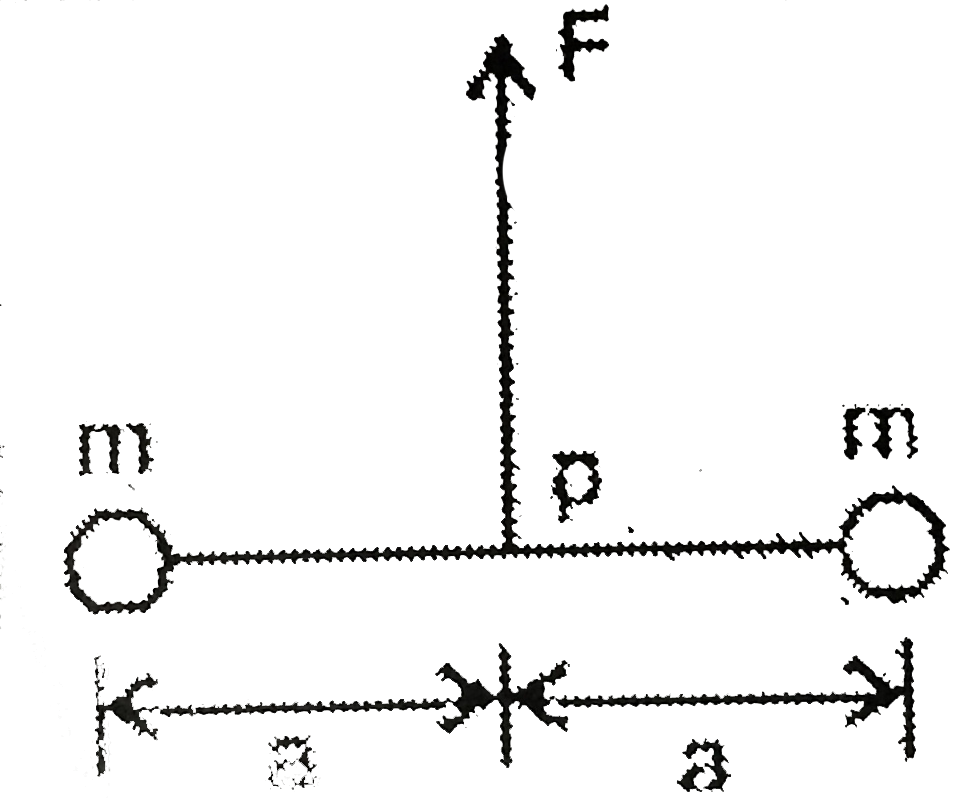
View SolutionA long, hollow conducting cylinder is kept coaxially inisde another long, hollow conducting cylinder of larger radius. Both the cylinders are initially electrically neutral.
View SolutionConisder a neutral conducting sphere. A poistive point charge is placed outisde the sphere. The net charge on the sphere is then
View SolutionA circuit is connected as shown in the figure with the switch S open. When the switch is closed, the total amount of charge that flows from Y to X is
 .
.
View SolutionA ray of light travelling in water is incident on its surface open to air. The angle of incidence is `theta`, which is less than the critical angle. Then there will be
View SolutionIn the options given below, let `E` denote the rest mass energy of a nucleus and `n` a neutron. The correct option is:
View SolutionThe largest wavelength in the ultraviolet region of the hydrogen spectrum is `122nm`. The smallest wavelength in the infrared region of the hydrogen spectrum (to the nearest interger) is (a) `802nm` (b) `823nm`
(c ) `1882nm` (d) `1648nm`.
View SolutionAsseration : A block of mass m starts moving on a rough horizontal surface with a velocity v. It stops due to friction between the block and the surface after moving through a ceratin distance. The surface is now tilted to an angle of `30^@` with the horizontal and same block is made to go up on the surface with the same initial velocity v. The decrease in the mechanical energy in the second situation is small than the first situation.
Reason : The coefficient of friction between the block and the surface decreases with the increase in the angle of inclination.
View SolutionSTATEMENT-l : In an elastic collision between two bodies, the relative speed of the bodies after collision is equal to the relative speed before the collision.
STATEMENT-2 : In an elastic collision, the linear momentum of the system is conserved.
View SolutionThe formula connecting u,v and f for a spherical mirror is valid only for mirrors whose sizes are very small compared to their radii of curvature. Because
Statement-2
Laws of reflection are strictly valid for plane surfaces, but nor for large spherical surfaces.s
View SolutionStatement-1
If the accelerating potential in an X-ray tube is increased, the wavelength of the characterstic X-rays do not change.
because
Statement-2
When an electron beam strikes the target in an X-ray tube, part of the kinetic energy is converted into X-ray energy.
View SolutionThe ratio `x_(1)//x_(2)` is
View SolutionTwo discs A and B are mounted coaxiallay on a vertical axle. The discs have moments of inertia I and 2 I respectively about the common axis. Disc A is imparted an initial angular velocity `2 omega` using the entire potential energy of a spring compressed by a distance `x_1` Disc B is imparted an angular velocity `omega` by a spring having the same spring constant and compressed by a distance `x_2` Both the discs rotate in the clockwise direction.
When disc B is brought in contact with disc A, they acquire a common angular velocity in time t. The average frictional torque on one disc by the other during this period is
View SolutionThe loss of kinetic energy during the above proces is
View SolutionA fixed thermally conducting cylinder has a radius R and height `L_0`. The cylinder is open at the bottom and has a small hole at its top. A piston of mass M is held at a distance L from the top surface, as shown in the figure. The atmospheric pressure is `P_0`.
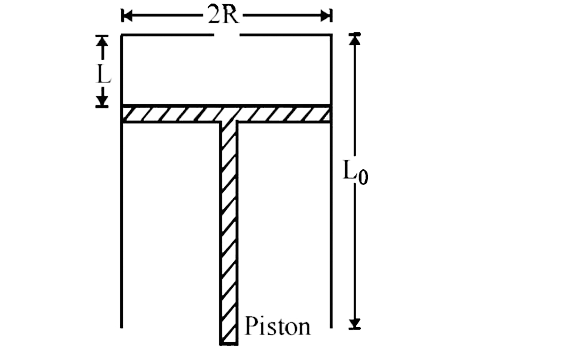
The piston is now pulled out slowly and held at a distance 2L from the top. The pressure in the cylinder between its top and the piston will then be
View SolutionA fixed thermally conducting cylinder has a radius R and height `L_0`. The cylinder is open at its bottom and has a small hole at its top. A piston of mass M is held at a distance L from the top surface, as shown in the figure. The atmospheric pressure is `P_0`.
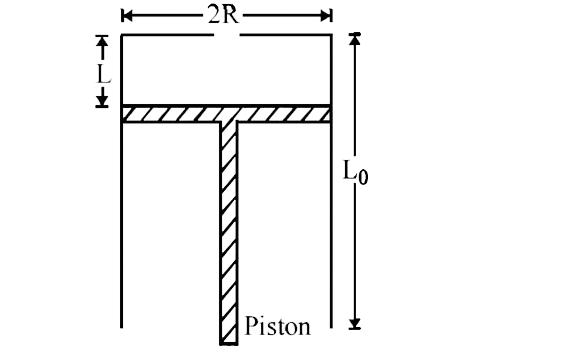
While the piston is at a distance 2L from the top, the hole at the top is sealed. The piston is then released, to a position where it can stay in equilibrium. In this condition, the distance of the piston from the top is
View SolutionA fixed thermally conducting cylinder has a radius R and height `L_0`. The cylinder is open at its bottom and has a small hole at its top. A piston of mass M is held at a distance L from the top surface, as shown in the figure. The atmospheric pressure is `P_0`.
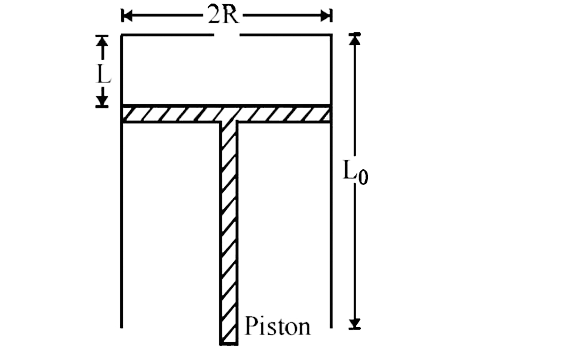
The piston is taken completely out of the cylinder. The hole at the top is sealed. A water tank is brought below the cylinder and put in a position so that the water surface in the tank is at the same level as the top of the cylinder as shown in the figure. The density of the water is `rho`. In equilibrium, the height H of the water coulmn in the cylinder satisfies
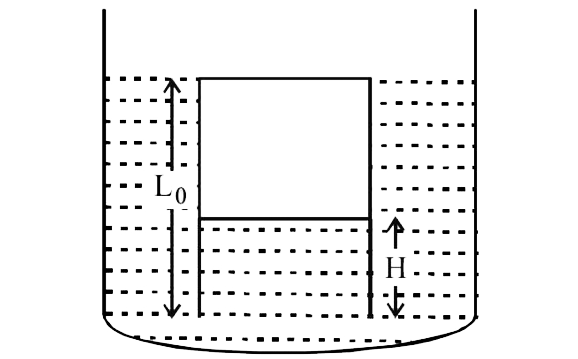
View SolutionSome physical quantities are given in Column I and some possible SI units in which these quantities may be expressed are given in Column II. Match the physical quantities in Column I with the units in column II and indicate your answer by darkening appropriate bubbles in the `4xx4` matrix given in the ORS.
`{:(,"Column-I",, "Column-II"),((A),GM_(e)M_(s),(P),("volt")("coulomb")("meter")),(,"G-universal gravitational ",,),(,"Constant",,),(,M_(e)-"mass of the earth",,),(,M_(s)-"mass of the Sun",,),((B),(3RT)/(3),(Q),("kilogram")("metre")^(3)),(,R-"universal gas constant",,),(,T-"absolute temperature",,),(,M-"molar mass",,),((C),(F^(2))/(q^(2)B^(2)),(R),("metre")^(2)("second")^(-2)),(,F-"force",,),(,q-"charge",,),(,B-"magnetic field",,),((D),(GM_(e))/(R_(e)),(S),("farad")("volt")^(2)("kg")^(-1)),(,G-"universal gravitational constant",,),(,M_(e)-"mass of the earth",,),(,R_(e)-"radius of the earth",,):}`
View SolutionColumn I gives certain situating in which a straight metallic wire of resitance R is used and Column II gives some resulting effects. Match the statements in Column I with the statements in Column II and indicate your answer by darkening appropriate bubbles in the `4 xx 4` matrix given in the ORS.

View SolutionSome lawa I processes are given in Column I. Match these with the physical phenomena given in Column II and indicate your answer by darkening appropriate bubbles in the `4 xx 4` matrix given in the ORS.

View SolutionFigure shows three resistor configurations R1,R2 and R3 connected to 3V vattery If the prower dissipated by the configuration R1,R2 and R3 is P1 ,m P2 and P3 repecitively then
Figure

View SolutionWhich one of the following statement is `WRONG` in the context of X- rays generated from X- rays tube ?
View SolutionTwo beams of red and violet colours are made to pass separately through a prism (angle of the prism is ` 60degree`). In the position of minimum deviation, the angle of refraction will be
View SolutionAn ideal gas is expanding such that `PT^(2)= `constant. The coefficient of volume expansion of lthe gas is:
View SolutionA spherically symmetric gravitational system of particles has a mass density` rho={(rho_0,for, r,lt,R),(0,for,r,gt,R):}` where`rho_0` is a constant. A test mass can undergo circular motion under the influence of the gravitational field of particles. Its speed v as a function of distahce `r(0ltrltOO)` form the centre of the system is represented by
View SolutionTwo balls having linear momenta `vecp_(1)=phati` and `vecp_(2)=-phati, ` undergo a collision in fre space. There is no external force acting on the ball. Let `vecp_(1)^(')` and `vecp_(2)^(')` be their final moment. Which of the following option(s) is (are) NOT ALLOWED for an non zero value of `p,a_(1),a_(2),b_(1),b_(2), c_(1)` and `c_(2).`
View SolutionAssume that the nuclear binding energy per uncleon `(B//A)` versus mass number `(A)` is as shwon in Fig. Use this plot to choose the correct choice `(s)` given below:
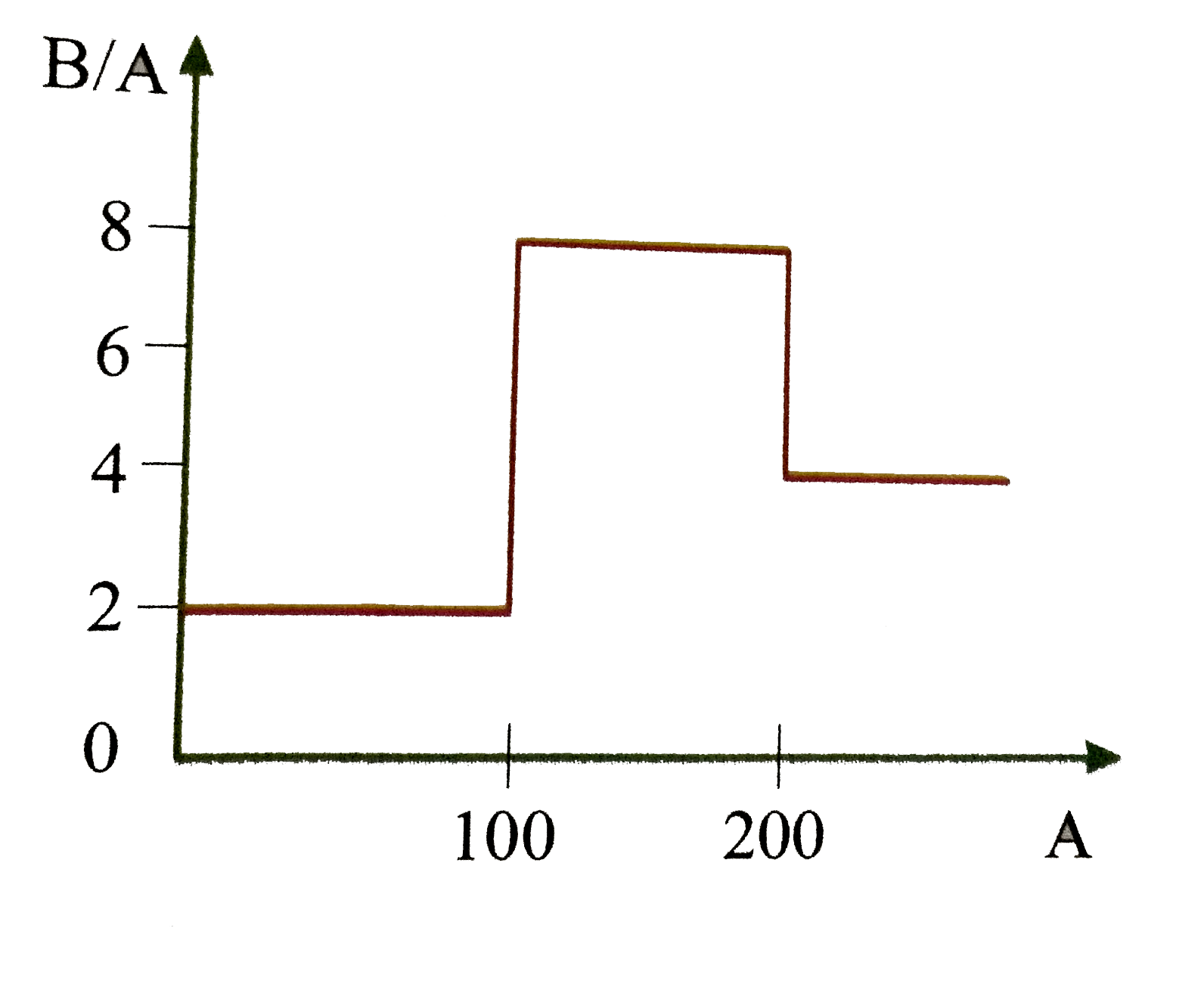
View SolutionA particle of mass `m`and charge `q`, moving with velocity `v` enters Region `II` normal to the boundary as shown in the figure. Region `II` has a uniform magnetic field `B` perpendicular to the plane of the paper . The length of the region `II` is `l`. Choose the correct choice(s).
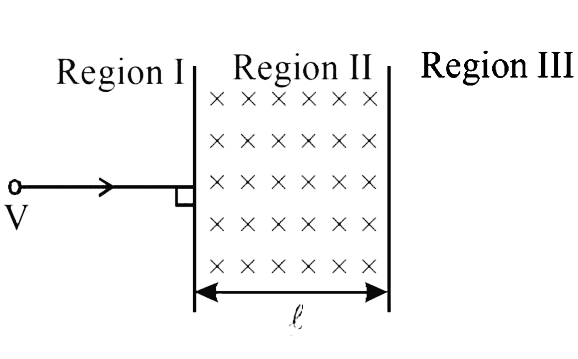
View SolutionIn a Young's double slit experiment, the separation between the two slits is d and the wavelength of the light is `lamda`. The intensity of light falling on slit 1 is four times the intensity of light falling on slit 2. Choose the correct choice (s).
View SolutionStatement-1 : In a Meter Bridge experiment, null point for an unknown resistance is measured. Now, the unknown resistance is put inside an enclosure maintained at a higher temperature. The null point can be obtained at the same point as before by decreasing the value of the standard resistance.
Statement-2 : Resistance of metal increases with increase in temperature.
View SolutionAssertion : An astronaut in an orbiting space station above the earth experience weightlessness.
Reason : An object moving around the earth under the infuence of earth's gravitational force is in a state of 'free fall'
View SolutionSatement-1: two cylinder one hollow (metal) and the other side (wood) with the same mass and identical dimensions are simultaneously allowed to roll wihtout slipping down an inclined plane from the same height. The hollow cylinder will reach the bottom of the inclined plane first.
Statement-2: By the principle of conservation of energy, the total kinetic energies of both the cylinder are identical when they reach the bottom of the incline.
View SolutionSTATEMENT-1: The stream of water flowing at high speed from a garden hose pipe tends to spread like a fountain when held vertically up, but tends to narrow down when held vertically down.
STATEMENT-2: In any steady flow of an incompressible fluid, the volume flow rate of the fluid remains constant.
View SolutionA small spherical monoatomic ideal gas bubble `(gamma=5//3)` is trapped inside a liquid of density `rho` (see figure). Assume that the bubble does not exchange any heat with the liquid. The bubble contains n moles of gas. The temperature of the gas when the bubble is at the bottom is `T_0`, the height of the liquid is H and the atmospheric pressure `P_0` (Neglect surface tension).

As the bubble moves upwards, besides the buoyancy force the following forces are acting on it
View SolutionA small spherical monoatomic ideal gas bubble `(gamma=5//3)` is trapped inside a liquid of density `rho` (see figure). Assume that the bubble does not exchange any heat with the liquid. The bubble contains n moles of gas. The temperature of the gas when the bubble is at the bottom is `T_0`, the height of the liquid is H and the atmospheric pressure `P_0` (Neglect surface tension).

When the gas bubble is at a height y from the bottom, its temperature is-
View SolutionA small spherical monoatomic ideal gas bubble `(gamma=5//3)` is trapped inside a liquid of density `rho` (see figure). Assume that the bubble does not exchange any heat with the liquid. The bubble contains n moles of gas. The temperature of the gas when the bubble is at the bottom is `T_0`, the height of the liquid is H and the atmospheric pressure `P_0` (Neglect surface tension).
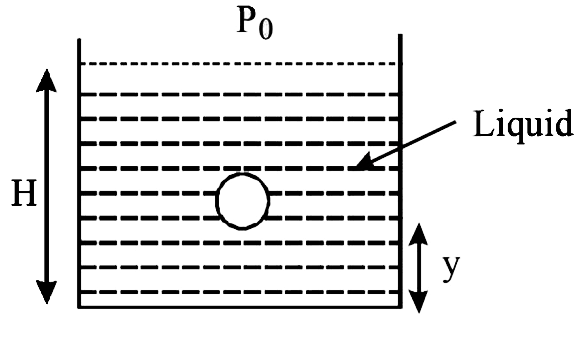
The buoyancy force acting on the gas bubble is (Assume R is the universal gas constant)
View SolutionIn a mixture of `H- He^(+)` gas (`He+ `is singly ionized He atom), `H` atom and `He+` ions are excited to their respective first excited state. Subsequently `H` atoms transfer their total excitation energy to `He+` ions (by collisions) Assume that the bohr model of atom is exactly valid.
The quantum number `n` of the state finally populated in `He^(+)` inos is -
View SolutionIn a mixture of `H- He^(+)` gas (`He+ `is singly ionized He atom), `H` atom and `He+` ions are excited to their respective first excited state. Subsequently `H` atoms transfer their total excitation energy to `He+` ions (by collisions) Assume that the bohr model of atom is exactly valid.
The wavelength of light emitted in the visible region by `He+` lons after collisions with `H` atoms is -
View SolutionIn a mixture of `H-He^(+)` gas (`He^(+)` is singly ionized `He` atom), `H` atoms and `He^(+)` ions are excited to their respective first excited states. Subsequently, `H` atoms transfer their total excitation energy to `He^(+)` ions (by collisions). Assume that the Bohr model of atom is exctly valid.
The ratio of the kinetic energy of the `n=2` electron for the `H` atom to that of `He^(+)` ion is:
View SolutionA small block of mass `M` moves on a frictionless surface of an inclined plane, as shown in the figure. The angle of the incline suddenly changes from `60^(@)` to `30^(@)` at point `B`. The block is many at rest at `A`. Assume that collisions between the block id the incline are totally inelastic.
The speed of the block at point `B` immediately after it strikes the second incline is
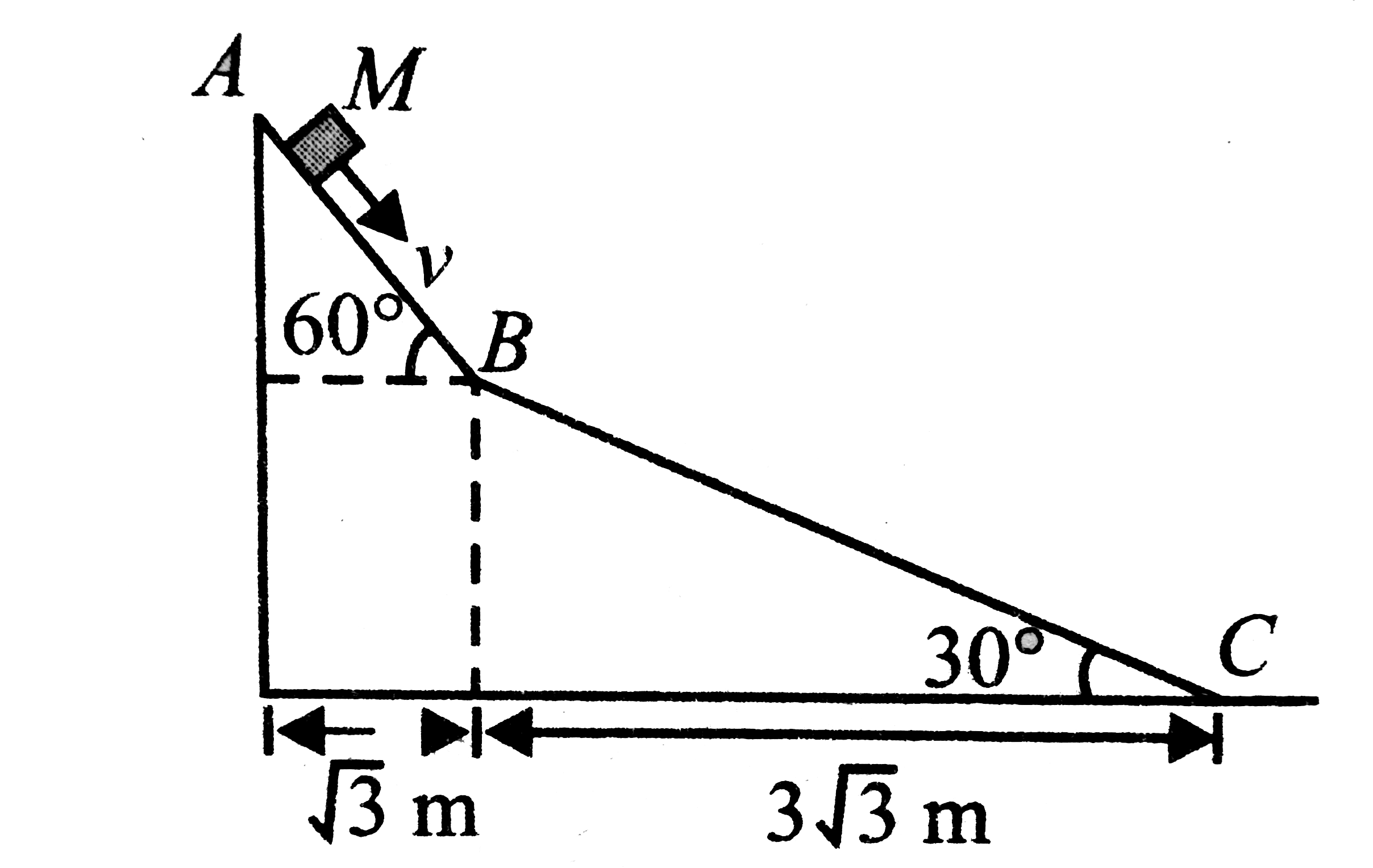
View SolutionA small block of mass `M` moves on a frictionless surface of an inclined plane, as shown in the figure. The angle of the incline suddenly changes from `60^(@)` to `30^(@)` at point `B`. The block is many at rest at `A`. Assume that collisions between the block id the incline are totally inelastic.
The speed of the block at point `C`, immediately before it leaves the second incline
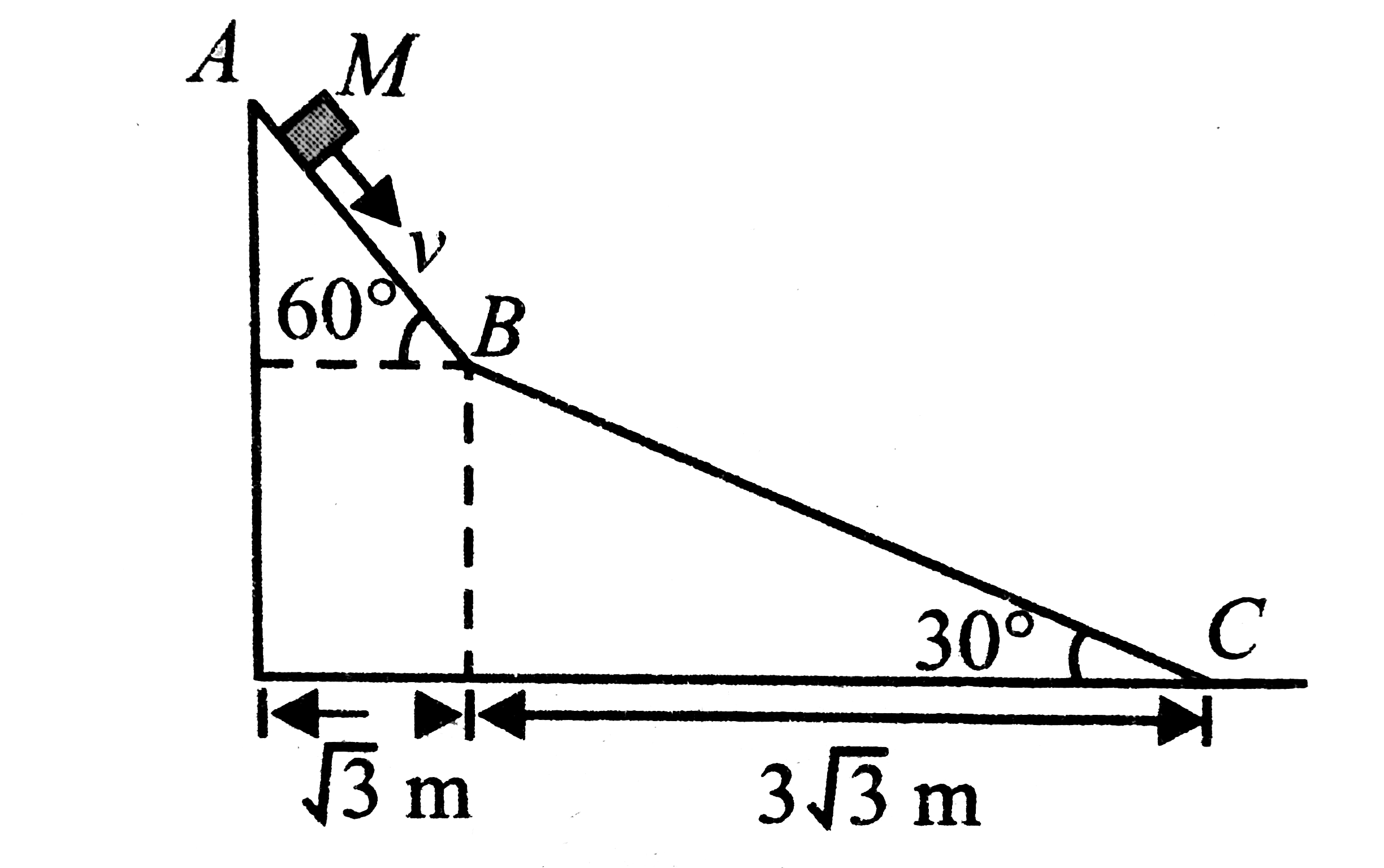
View SolutionA small block of mass `M` moves on a frictionless surface of an inclined plane, as shown in the figure. The angle of the incline suddenly changes from `60^(@)` to `30^(@)` at point `B`. The block is many at rest at `A`. Assume that collisions between the block id the incline are totally inelastic.
If collision between the block and the incline is completely elastic, then the vertical (upward) component of the velocity of the blocks at point `B`, immediately after it strikes the second incline is

View SolutionA radioactive sample `S_1` having an activity of `5muCi` has twice the number of nuclei as another sample `S_2` which has an activity of `10muCi`. The half-lives of `S_1` and `S_2` can be
View SolutionA transverse sinusoidal wave moves along a string in the positive x-direction at a speed of `10m//s`. The wavelength of the wave is `0.5m` and its amplitude is `10cm`. At a particular time `t`, the snap-shot of the wave is shown in figure. The velocity of point `P` when its displacement is `5cm` is -

View SolutionA block `(B)` is attached to two unstriched sprig `S_(1)` and S_(2) with spring constant `K` and `4K` , respectively (see fig 1) The other ends are atteched in identical support `M_(1)` and `M_(2)` not attached in the walls . The springs and supports have negligible mass . There is no friction anywhere . The block `B` is displaced toword wall `1` by a small distance `z` (figure (ii)) and released . THe block return and moves a maximum displacements `x` and `y` are musured with reoact to the equalibrum of the block `B` and the ratio `y//x` is

View SolutionA bob of mass M is suspended by a massless string of length L. The horizonta velocity v at position A is just sufficient to make it reach the point B. The angle `theta` at which the speed of the bob is half of that at A, satisfies

View SolutionA glass tube of uniform internal radius `(r)` has a valve separating the two identical ends. Initially, the valve is in a tightly closed position. End `1` has a hemispherical soap bubble of radius `r`. End `2` has sub-hemispherical soap bubble as shown in figure. Just after opening the valve.
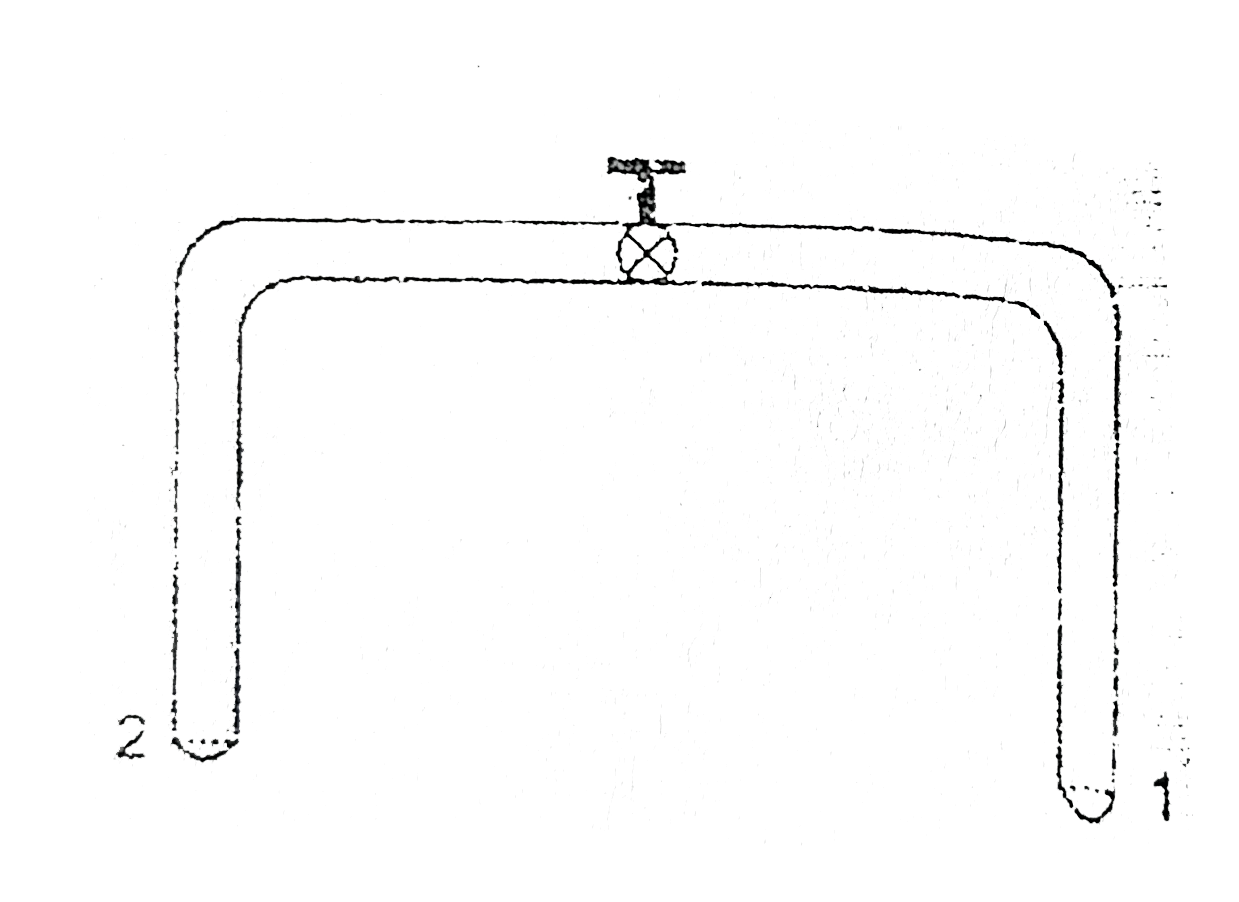
View SolutionA vibrating string of certain length `l` under a tension `T` resonates with a mode corresponding to the first overtone (third harmonic) of an air column of length `75cm` inside a tube closed at one end. The string also generates `4` beats per second when excited along with a tuning fork of frequency `n`. Now when the tension of the string is slightly increased the number of beats reduces `2` per second. Assuming the velocity of sound in air to be `340 m//s`, the frequency `n` of the tuning fork in `Hz` is
View SolutionA parallel plate capacitor C with plates of unit area and separation d is filled with a liquid of dielectric constant `K=2`. The level of liquid is `d//3` initially. Suppose the liquid level decreases at a constant speed v, the time constant as a function of time t is-
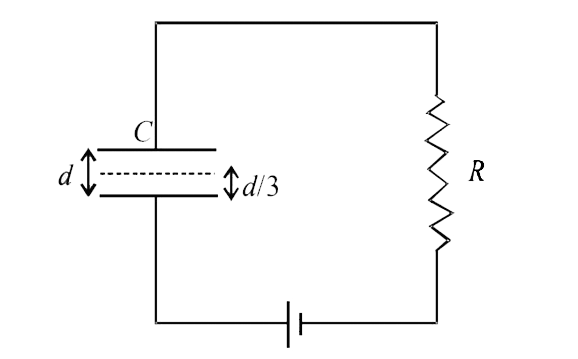
View SolutionA light beam is traveling from Region I to region IV (refer figure). The refractive indices in Region I, II, III, and IV are `n_(0), n_(0)//2,n_(0)//6 and n_(0)//8` , respectively. The angle of incidence `theta` for which the beam just misses entering Region IV is
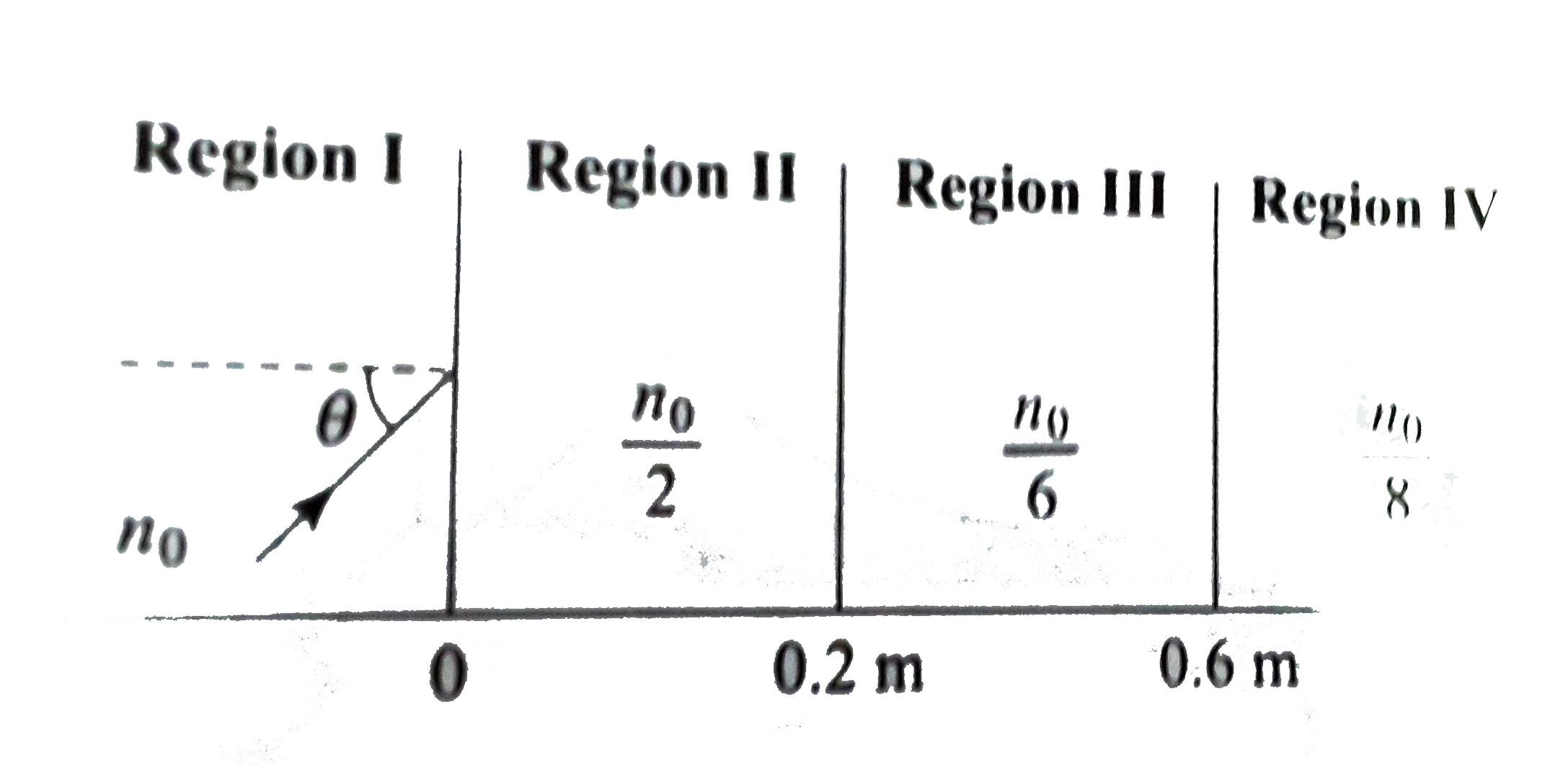
View SolutionSTATEMENT -1 : For an observer looking out through the window of a fast moving train , the nearby objects appear to move in the opposite direction to the train , while the distant objects appear to be stationary .
STATEMENT - 2 : If the observer and the object are moving at velocities ` vec v_(1)` and `vec v_(2)` respecttively with refrence to a laboratory frame , the velocity of the object with respect to a laboratory frame , the velocity of the object with respect to the observer is `vecv_(2) - vecv(1) ` .
(a) Statement -1 is True, statement -2 is true , statement -2 is a correct explanation for statement -1
(b) Statement 1 is True , Statement -2 is True , statement -2 is NOT a correct explanation for statement -1
(c) Statement - 1 is True , Statement -2 is False
(d) Statement -1 is False, Statement -2 is True
View SolutionSTATEMENT-1: It is easier to pull a heavy object than to push it on a level ground and
STATEMENT-2: The magnitude fo frictional force depends on the nature of the two surfaces in contact.
View SolutionSTATEMENT-1: For practical purposes, the earth is used as a reference at zero potencial in electrical circuits. and
STATEMENT-2: The electrical potential of a sphere of radius R with charge Q uniformly distributed on the surface is given by `(Q)/(4piepsilon_0R)`.
View SolutionSTATEMENT-1: For practical purposes, the earth is used as a reference at zero potencial in electrical circuits. and
STATEMENT-2: The electrical potential of a sphere of radius R with charge Q uniformly distributed on the surface is given by `(Q)/(4piepsilon_0R)`.
View SolutionThe nuclear charge (`Ze`) is non uniformlly distribute with in a nucleus of radius r. The charge density `rho(r)` (charge per unit volume) is dependent only on the radial distance r form the centre of the nucleus s shown in figure. The electric field is only along the radial direction.

The electric field at `r=R` is
View SolutionThe nuclear charge (`Ze`) is non uniformlly distribute with in a nucleus of radius `r`. The charge density `rho(r)` (charge per unit volume) is dependent only on the radial distance r form the centre of the nucleus s shown in figure. The electric field is only along the radial direction.

For a=0 the value of d (maximum value of `rho` as shown in the figure) is
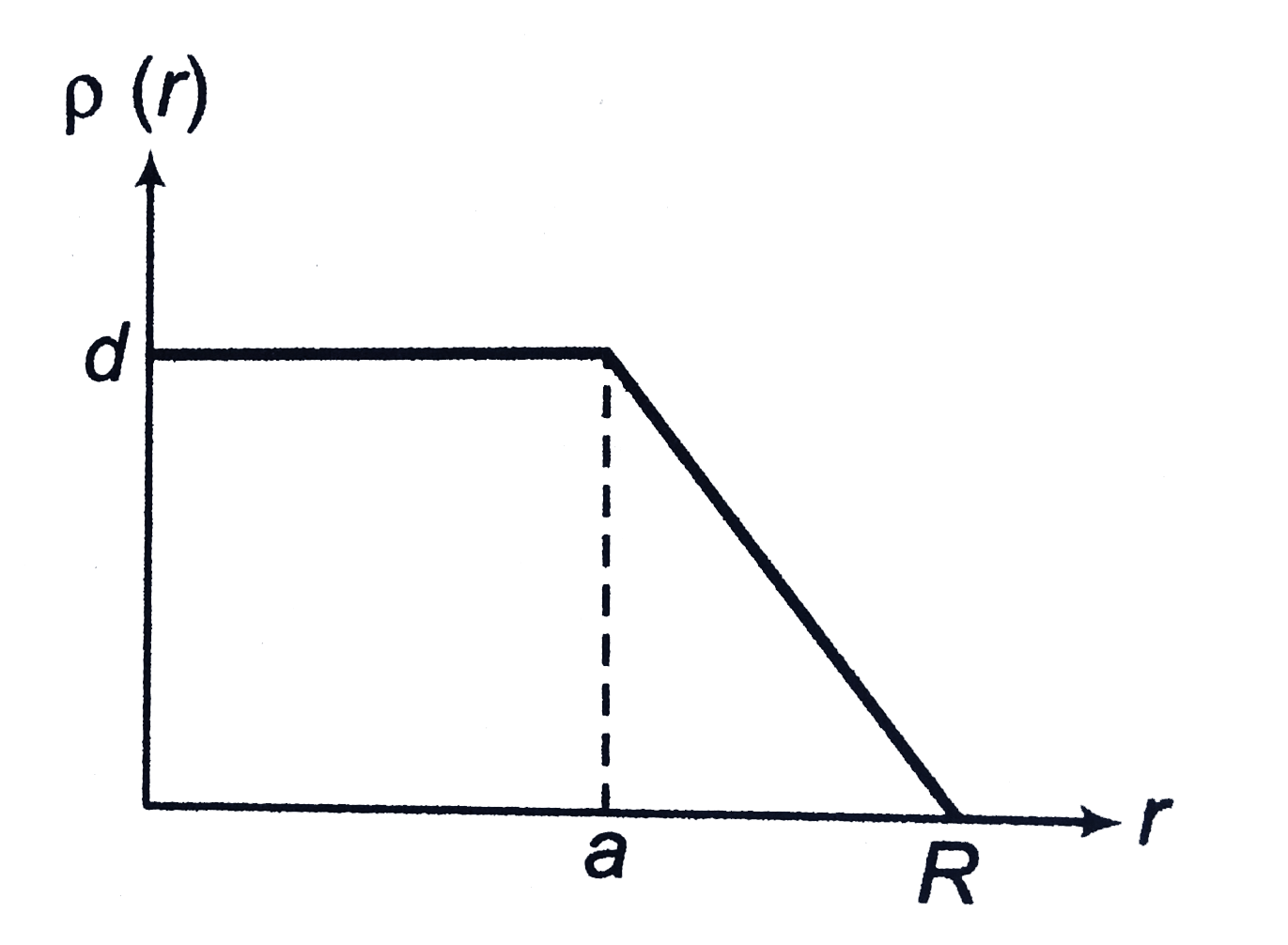
View SolutionThe nuclear charge (`Ze`) is non uniformlly distribute with in a nucleus of radius r. The charge densilty `rho(r)` (charge per unit volume) is dependent only on the radial distance r form the centre of the nucleus s shown in figure. The electric field is only along the radial direction.

The electric field within the nucleus is generaly observed to be linearly dependent on r. This implies
View SolutionA uniform thin cylindrical disk of mass M and radius R is attaached to two identical massless springs of spring constatn k which are fixed to the wall as shown in the figure. The springs are attached to the axle of the disk symmetrically on either side at a distance d from its centre. The axle is massless and both the springs and the axle are in horizontal plane. the unstretched length of each spring is L. The disk is initially at its equilibrium position with its centre of mass (CM) at a distance L from the wall. The disk rolls without slipping with velocity `vecV_0 = vacV_0hati.` The coefficinet of friction is `mu.`
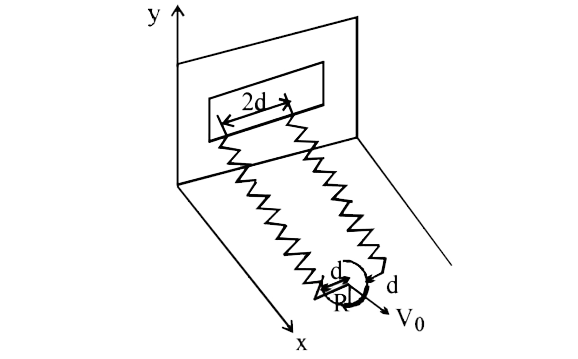
The net external force acting on the disk when its centre of mass is at displacement x with respect to its equilibrium position is.
View SolutionA uniform thin cylindrical disk of mass M and radius R is attaached to two identical massless springs of spring constatn k which are fixed to the wall as shown in the figure. The springs are attached to the axle of the disk symmetrically on either side at a distance d from its centre. The axle is massless and both the springs and the axle are in horizontal plane. the unstretched length of each spring is L. The disk is initially at its equilibrium position with its centre of mass (CM) at a distance L from the wall. The disk rolls without slipping with velocity `vecV_0 = vacV_0hati.` The coefficinet of friction is `mu.`
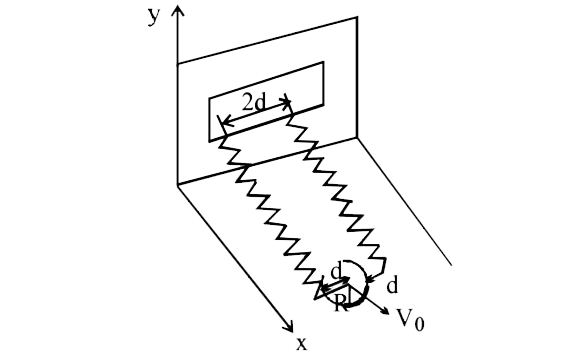
The centre of mass of the disk undergoes simple harmonic motion with angular frequency `omega` equal to -
View SolutionA uniform thin cylindrical disk of mass M and radius R is attaached to two identical massless springs of spring constatn k which are fixed to the wall as shown in the figure. The springs are attached to the axle of the disk symmetrically on either side at a distance d from its centre. The axle is massless and both the springs and the axle are in horizontal plane. the unstretched length of each spring is L. The disk is initially at its equilibrium position with its centre of mass (CM) at a distance L from the wall. The disk rolls without slipping with velocity `vecV_0 = vacV_0hati.` The coefficinet of friction is `mu.`
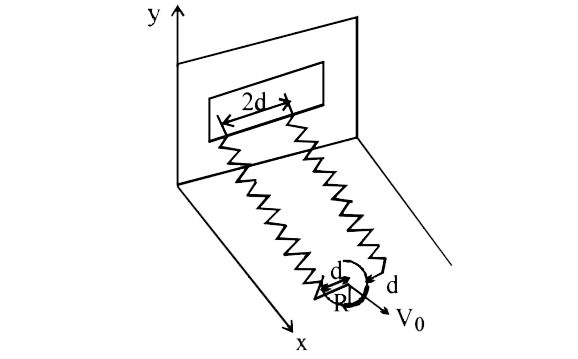
The maximum value of `V_0` for whic the disk will roll without slipping is-
View SolutionColumn I gives a listof possible set of parameters measured in some experiments. The variations of the parameters in the form of graphs are shown in Column II. Match the set of parameters given in Column I with the graphs even in Column II. Indicate your answer by darkening the appropriate bubbles of the `4 xx 4` matrix given in the ORS.
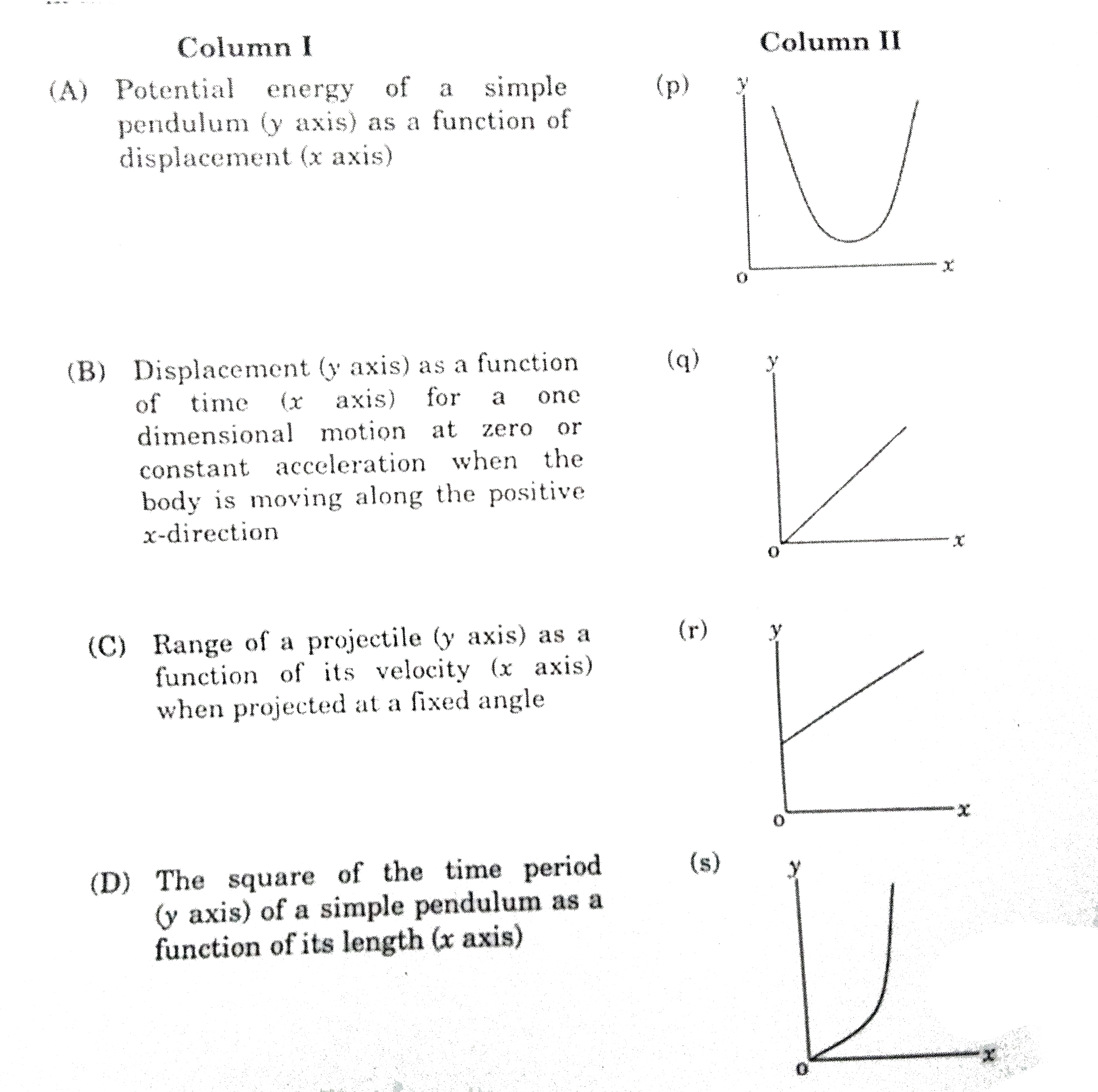
View SolutionAn optical component and an object S placed along its optic axis are given in Column I. The distance between the object and the components can be varied. The properties of images are given in Column II. Match all the properties of images from Column II with the appropriate components given in Column I. Indicate your answer by darkening the appropriate bubbles of the `4 xx 4` matrix given in the ORS.

View SolutionColumn I contains a list of processes involving expansion of an ideal gas. Match this with Column II describing the thermodynamic change during this process. Indicate your answer by darkening the appropriate bubbles of the `4 xx 4` matrix given in the ORS.
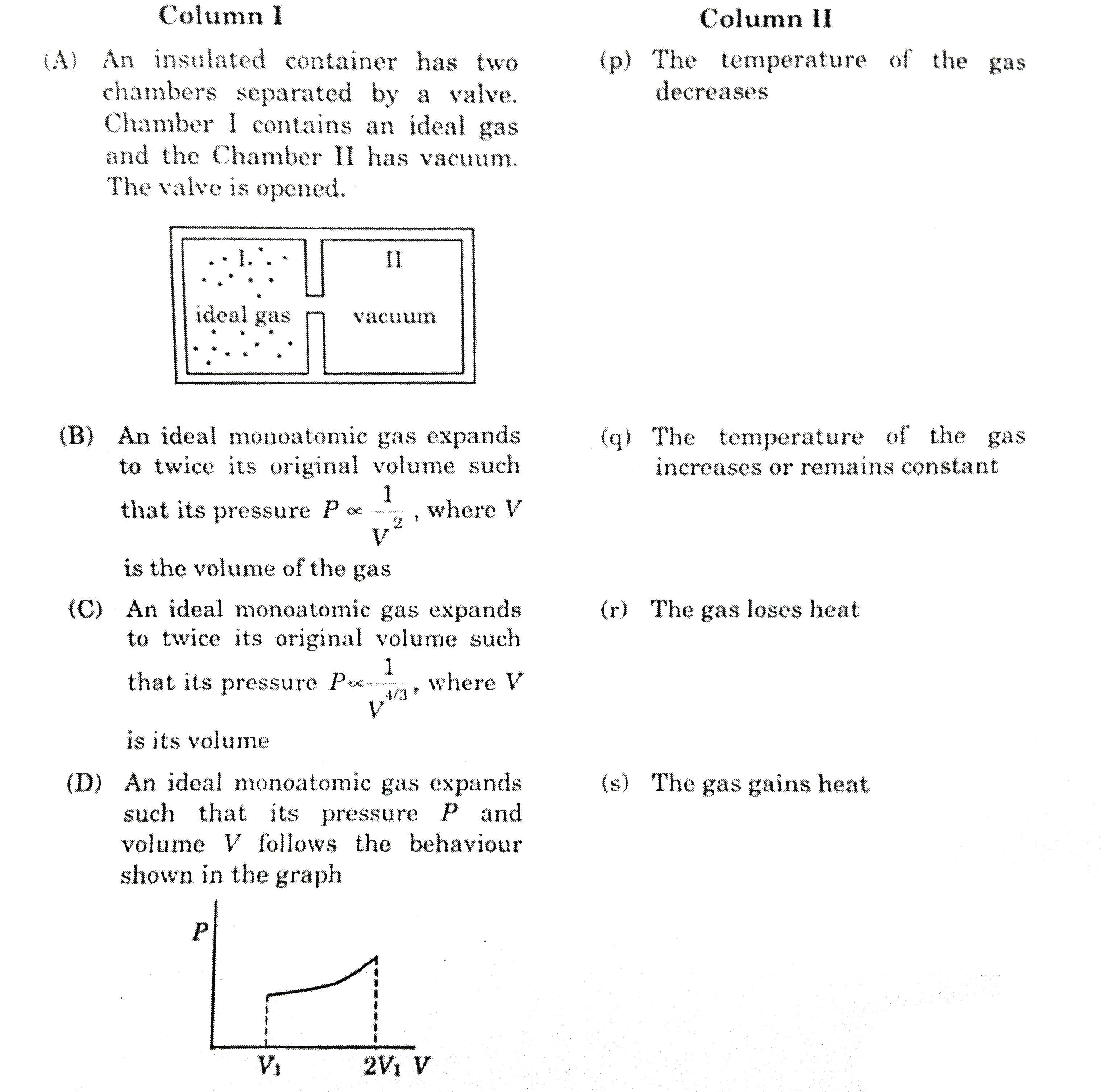
View Solution
PHYSICS questions and complete solutions for chapter JEE ADVANCED of JEE ADVANCED PREVIOUS YEAR of Class 12
All Exercises from JEE ADVANCED PREVIOUS YEAR Class 12 PHYSICS JEE ADVANCED
- MULTIPLE CHOICE QUESTIONS
- PART I : PHYSICS (SECTION -1)
- PART I : PHYSICS (SECTION -2)
- PART I : PHYSICS (SECTION -3)
- PART I : PHYSICS (SECTION 1)
- PART I : PHYSICS (SECTION 3)
- Part I : PHYSICS (Section 3)Paragraph 2
- PART I: PHYSICS SECTION-2: (Paragraph Type)
- PART I: PHYSICS SECTION-3: (Paragraph Type)
- PART I: PHYSICS Section-3:(Matching List Type)
- PART I: PHYSICS (SECTION-1) (One or more options correct Type)
- PART-1 PHYSICS (SECTION 1 )
- PART-1 PHYSICS (SECTION 2 )
- PART-1 PHYSICS (SECTION 3 )
- PHYSICS
- PHYSICS SECTION - I : Single correct Answer Type
- PHYSICS SECTION - II : Multiple correct Answer Type
- PHYSICS SECTION - III Integer Answer Type
- PHYSICS SECTION - IV Matrix Match Type
- SECTION - 1 (ONE OR MORE THAN ONE OPTIONS CORRECT TYPE)
- SECTION - 1 (ONLY ONE OPTION CORRRECT TYPE)
- Section - I Single correct Answer Type
- Section - II (Multiple correct Answer Type)
- Section - III (Paragraph Type)
- Section - IV (Integer Answer Type)
- Section -(III) (Paragraph type)
- SECTION -1
- SECTION -2
- SECTION -2 ( ONE INTEGER VALUES CORRECT TYPE)
- SECTION -2 COMPREHENSION TYPE
- SECTION -3 (MATCHING LIST TYPE)
- Section -IV (Integer type)
- Section -IV (matrix type)
- SECTION 1
- SECTION 2
- SECTION 3 PARAGRAPH 3
- Section I : Single Correct Answer Type
- Section II : Paragraph Type
- Section III : Multiple Correct Answer(s) Type
- Section-1
- Section-2
- SECTION-I (Single correct Choice Type )
- Section-I (single correct choice type)
- SECTION-I( Single Correct Choice Type )
- Section-II (Integer type)
- SECTION-II ( Multiple Correct Choice Type )
- SECTION-II (Multiple correct Choice Type )
- Section-II (Multiple correct choice type)
- SECTION-III ( Comprehension Type )
- SECTION-III (Comprehension Type )
- Section-III (Paragraph)
- SECTION-IV (Integer Answer Type )
- SECTION-IV( Matrix-Match Type )